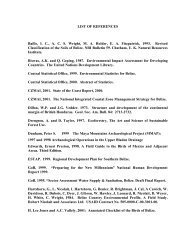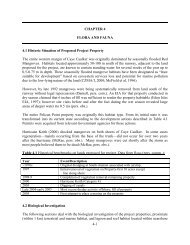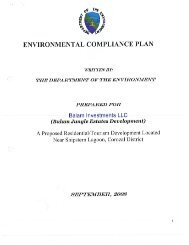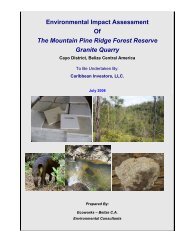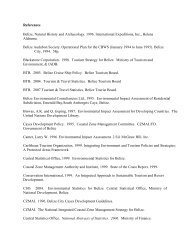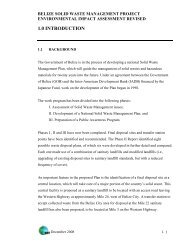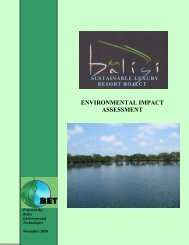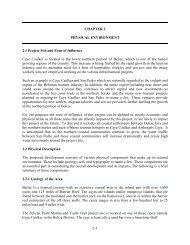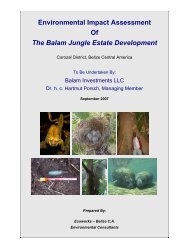Ambergris Caye Belize Resort Development - Department of ...
Ambergris Caye Belize Resort Development - Department of ...
Ambergris Caye Belize Resort Development - Department of ...
Create successful ePaper yourself
Turn your PDF publications into a flip-book with our unique Google optimized e-Paper software.
Most <strong>of</strong> the grasses and weeds, and vines, and herbaceous bracts and shrubs were confined to the<br />
Beach Berm [See PL 2.17], and the seaward 1/4 th <strong>of</strong> the Littoral Forest Seaward Consolidated<br />
Berm. The succeeding berms or ridges were heavily forested. Except for a small area at the midlatitude<br />
<strong>of</strong> the property immediately landward <strong>of</strong> the beach berm, as well as the survey trails [See<br />
PLs’ 2.18 and 2.27 respectively], there were no signs <strong>of</strong> previous land-clearing [Pers. comm.., G.<br />
Myvett]. The forest was surmised to be <strong>of</strong> primary growth form [See PL’s 2.19 & 2.20].<br />
The Mangrove Scrub component <strong>of</strong> the forest included two (2) components, viz: an area<br />
characterized by littoral forest species interspersed by mangroves species, and a zone dominated<br />
90-100% by mangroves. The mixed mangrove shrub component was located mainly in the area<br />
titled ‘Littoral Forest Lagunal Berm’. The mangrove species found in this area were the Black<br />
Mangrove (Avicennia germinans) and the White Mangrove (Laguncularia racemosa) [See Table<br />
2.2A]. The more frequently encountered species was the Black Mangrove (Avicennia<br />
germinans).<br />
The monospecific mangrove zone has been defined as the Laguna de Cantena Low-lands<br />
[LdCLL] in Table 2.2A. Although all three (3) species <strong>of</strong> mangroves present in <strong>Belize</strong> were<br />
found in the area, the most dominant species was the Red Mangrove (Rhizophora mangle) [See<br />
PL’s 2.7 & 2.8], followed by the Black Mangrove (Avicennia germinans).<br />
Apart from the land-based trees, shrubs and grasses, the site was also richly invested with subtidal<br />
or sea-based plant life. The dominant species was the Turtle Grass (Thalassia testudinium)<br />
which formed extensive meadows or ‘bed’ [See PL’s 2.2 & 2.3], which proceeded from the<br />
nearshore areas, to the medial shallows about 400-500 m from the shoreline [See D Fig. 2.1].<br />
Apart from the Turtle Grass (Thalassia testudinium) [See PL 2.12], the two (2) other seagrass<br />
species found in the area included the Manatee Grass (Syringodium filiforme) [See PL 2.13] and<br />
Halodule (Halodule beaudettel) [See Table 2.2A].<br />
The macro-algae figured prominently in regards to the sub-tidal species found in the area. The<br />
Shag Carpet Algae (Dasycladus vermicularis) was found in great pr<strong>of</strong>usion in the Laguna de<br />
Cantena. The Disc Tree Halimeda (Halimeda copiosa) [See PL 2.11] was found in the midreaches<br />
<strong>of</strong> the barrier lagoon in the seas <strong>of</strong>f the front or eastern side <strong>of</strong> the property. The floating<br />
seaweed or sargassum (Sargassum polycerathum) was also found <strong>of</strong>f the front <strong>of</strong> the property in<br />
the barrier lagoon, as well as on the beach [See PL’s 2.6, 2.17 & 2.22]. Other macro-algal<br />
species <strong>of</strong> note found in the area include: the Dichotomously Branched Algae (Dictyota spp.),<br />
Valonia (Valonia ventricosa), the Feather Algae (Caulerpa prolifera) and the Cactus Branchlets<br />
(Caulerpa cupressoides) [See Table 2.2B].<br />
Much <strong>of</strong> the macor-algae were found in the primary reef zone, including the pavement area and<br />
backreef zone [See F, Fig. 2.1].<br />
Grimshaw and Paz [2004] cited the existence <strong>of</strong> 37 species seagrasses and macro-algae in the<br />
greater Bacalar Chico National Park and Marine Reserve [BCNP/MR]. The Tunich Nah Survey<br />
Team documented 19 species, <strong>of</strong> which 3 were not previously cited by Grimsha and Paz [2004].<br />
2-11




